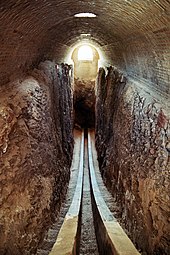সঠিক বিজ্ঞান

সঠিক বিজ্ঞান, প্রকৃত বিজ্ঞান অথবা পরিমাণগত বিজ্ঞান বা কদাচিৎ প্রকৃত গাণিতিক বিজ্ঞান,[১] বলতে সে সকল বিজ্ঞানকে বোঝানো হয় যেখানে "ফলাফলসমূহ তাদের চুড়ান্ত সঠিকতার ব্যাপারে দায়বদ্ধ"।[২] সঠিক বিজ্ঞানের উদাহরণ হলো গণিত, আলোকবিজ্ঞান, জ্যোতির্বিদ্যা,[৩] এবং পদার্থবিদ্যা, যেগুলোকে দেকার্তে, লাইবনিৎস এবং কান্ট থেকে শুরু করে যৌক্তিক ইতিবাদীগণ যৌক্তিক এবং বস্তুগত জ্ঞান হিসেবে বিবেচনা করেছেন।[৪] প্রাচীন বিভিন্ন সংস্কৃতিতেই এসকল বিজ্ঞানের চর্চা হয়েছে,[৫][৬] এবং আধুনিক কালেও হচ্ছে।[৭][৮] গণিতের সাথে একসূত্রেগাঁথা এসব বিজ্ঞানের বিশেষত্ব হলো পরিমাণগত রাশিমালা, নিখুঁত ভবিষ্যৎবাণী, এবং/অথবা অণুকল্প যাচাইয়ের জন্য কঠিন পদ্ধতির পরীক্ষানিরীক্ষা, যাতে পরিমাপযোগ্য ভবিষ্যৎবাণী এবং পরিমাপসংক্রান্ত বিষয়গুলো অন্তর্ভুক্ত থাকে।[৯]
পরিমাণগত প্রকৃত বিজ্ঞান এবং কারণ অনুসন্ধানী বিজ্ঞানের মধ্যকার পার্থক্য প্রতিষ্ঠিত হয় অ্যারিস্টটলের হাত ধরে, যিনি গণিতকে প্রাকৃতিক দর্শন থেকে পৃথক করেন[১০] এবং সঠিক বিজ্ঞানগুলোকে "গণিতের শাখা হিসেবে বেশি যৌক্তিক" বলে মনে করতেন।[১১] থমাস আকুইনাস এই পার্থক্যটি ব্যবহার করে বলেছিলেন, জ্যোতির্বিদ্যা গাণিতিক যুক্তি দ্বারা পৃথিবীর গোলাকার আকৃতি ব্যাখ্যা করে, যেখানে পদার্থবিজ্ঞান ব্যবহার করে বস্তুগত কার্যকারণ।[১২][১৩] ১৭ শতকের বৈজ্ঞানিক বিপ্লব পর্যন্ত এই পার্থক্যটি ব্যাপকভাবে গৃহীত হলেও সর্বজনীনভাবে গৃহীত হয়নি।[১৪] এডওয়ার্ড গ্রান্ট প্রস্তাব করেন, নতুন বিজ্ঞানের দিকে পরিচালনাকারী একটি মৌলিক পরিবর্তন ছিল সঠিক বিজ্ঞান এবং (কেপলার, নিউটন এবং অন্যান্যদের দ্বারা) পদার্থবিজ্ঞানের একীকরণ, যার ফলে বিজ্ঞানে প্রাকৃতিক ঘটনার পেছনের ভৌত কারণগুলোর পরিমাণগত অনুসন্ধানের সূত্রপাত ঘটেছে।[১৫]
ভাষাতত্ত্ব এবং তুলনামূলক ভাষাবিজ্ঞানকেও সঠিক বিজ্ঞান হিসাবে বিবেচনা করা হয়েছে, বিশেষ করে বেঞ্জামিন হোর্ফের দ্বারা।[১৬]
সঠিক বিজ্ঞানসমূহ
[সম্পাদনা]যা সঠিক বিজ্ঞান নয়
[সম্পাদনা]আরও দেখুন
[সম্পাদনা]তথ্যসূত্র
[সম্পাদনা]- ↑ Grant, Edward (২০০৭), A History of Natural Philosophy: From the Ancient World to the Nineteenth Century, Cambridge: Cambridge University Press, পৃষ্ঠা 43, আইএসবিএন 9781139461092
- ↑ "Exact, adj.1", Oxford English Dictionary, Online version (2nd সংস্করণ), Oxford: Oxford University Press, জুন ২০১৬
- ↑ Drake, Stillman; Swerdlow, N.M.; Levere, T.H. (১৯৯৯)। Essays on Galileo and the History and Philosophy of Science: Volume 1। University of Toronto Press। আইএসবিএন 978-0-8020-7585-7। ডিওআই:10.3138/j.ctvcj2wt5।
- ↑ Friedman, Michael (১৯৯২), "Philosophy and the Exact Sciences: Logical Positivism as a Case Study", Earman, John, Inference, Explanation, and Other Frustrations: Essays in the Philosophy of Science, Pittsburgh series in philosophy and history of science, 14, Berkeley and Los Angeles: University of California Press, পৃষ্ঠা 84, আইএসবিএন 9780520075771
- ↑ Neugebauer, Otto (১৯৬২), The Exact Sciences in Antiquity, The Science Library (2nd, reprint সংস্করণ), New York: Harper & Bros.
- ↑ Sarkar, Benoy Kumar (১৯১৮), Hindu Achievements in Exact Science: A Study in the History of Scientific Development, London / New York: Longmans, Green and Company, আইএসবিএন 9780598626806
- ↑ Harman, Peter M.; Shapiro, Alan E. (২০০২), The Investigation of Difficult Things: Essays on Newton and the History of the Exact Sciences in Honour of D. T. Whiteside, Cambridge: Cambridge University Press, আইএসবিএন 9780521892667
- ↑ Pyenson, Lewis (১৯৯৩), "Cultural Imperialism and Exact Sciences Revisited", Isis, 84 (1): 103–108, এসটুসিআইডি 144588820, জেস্টোর 235556, ডিওআই:10.1086/356376, বিবকোড:1993Isis...84..103P,
[M]any of the exact sciences… between Claudius Ptolemy and Tycho Brahe were in a common register, whether studied in the diverse parts of the Islamic world, in India, in Christian Europe, in China, or apparently in Mesoamerica.
- ↑ Shapin, Steven (২০১৮)। The Scientific Revolution (2nd সংস্করণ)। Chicago, IL: The University of Chicago Press। পৃষ্ঠা 46–47। আইএসবিএন 9780226398341।
- ↑ Principe, Lawrence (২০১১)। The Scientific Revolution: A Very Short Introduction। New York, NY: Oxford University Press। পৃষ্ঠা 27। আইএসবিএন 9780199567416।
- ↑ Grant, Edward (২০০৭), A History of Natural Philosophy: From the Ancient World to the Nineteenth Century, Cambridge: Cambridge University Press, পৃষ্ঠা 42–43, আইএসবিএন 9781139461092
- ↑ Cormack, Lesley (১৯৯৪)। "Flat Earth or round sphere: misconceptions of the shape of the Earth and the fifteenth-century transformation of the world."। Ecumene। 1 (4): 365 – JSTOR-এর মাধ্যমে।
- ↑ Aquinas, Thomas, Summa Theologica, Part I, Q. 1, Art. 1, Reply 2, সংগ্রহের তারিখ ৩ সেপ্টেম্বর ২০১৬,
For the astronomer and the physicist both may prove the same conclusion: that the earth, for instance, is round: the astronomer by means of mathematics (i.e. abstracting from matter), but the physicist by means of matter itself.
- ↑ Grant, Edward (২০০৭), A History of Natural Philosophy: From the Ancient World to the Nineteenth Century, Cambridge: Cambridge University Press, পৃষ্ঠা 303–305, আইএসবিএন 9781139461092
- ↑ Grant, Edward (২০০৭), A History of Natural Philosophy: From the Ancient World to the Nineteenth Century, Cambridge: Cambridge University Press, পৃষ্ঠা 303, 312–313, আইএসবিএন 9781139461092
- ↑ Benjamin Whorf, Linguistics as an exact science. In Language, thought and reality: Selected writings of Benjamin Lee Whorf. Edited by J.B. CarrollM.I.T. Press, 1956, 20–232.
